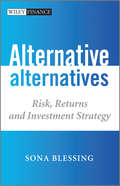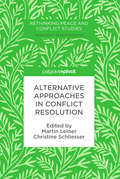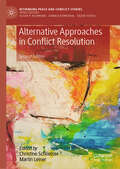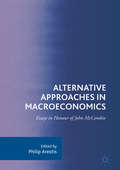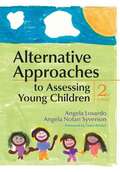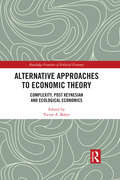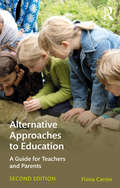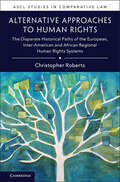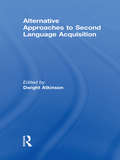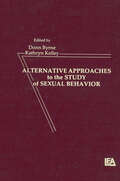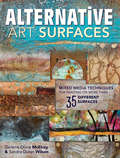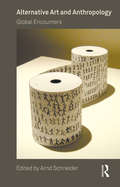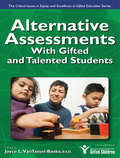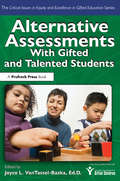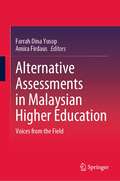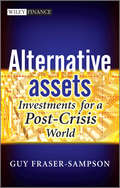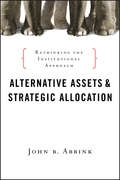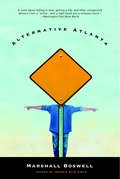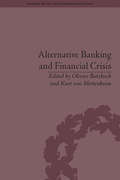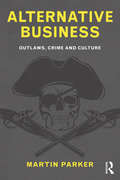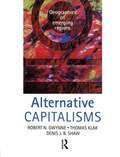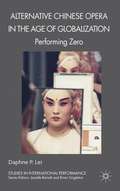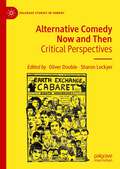- Table View
- List View
Alternative Alternatives
by Sona BlessingIn the aftermath of the financial crisis, investors are searching for new opportunities and products to safeguard their investments for the future. Riding high on the wave of new financial opportunities are Alternative Alternatives (AA). However, there is a dearth of information on what Alternative Alternatives are, how they work, and how they can be profited from.The book defines what Alternative Alternatives are, based on research and the following hypothesis: If the source (origin) of the risk lies outside of the financial markets, then it should be insulated from the vagaries of those markets. The book identifies and examines such and other unique, idiosyncratic, and difficult to replicate sources of risk - assets and strategies. The recent credit and sovereign debt crisis have served to defend the hypothesis and have upheld the conclusion that alternative alternative assets and strategies offer a risk-return profile that is distinct to those offered by traditional and main stream hedge fund strategies. These strategies include timberland investing, insurance risk transfer, asset/loan based lending (aviation, shipping, trade, entertainment, litigation financing etc), collectables and extraction strategies such as volatility and behaviour finance.This book will be a one stop resource to the new investment class known globally as Alternative Alternatives (AA) and will provide a comprehensive but accessible introduction to these assets. It provides an in-depth analysis of the assets and strategies which will leave investors with everything they need to identify and allocate to the best AA for them. It reviews the asset on a standalone basis, providing an explanation of the product, its characteristics, a SWOT analysis, and details its risk/reward drivers. The book also looks at how to integrate the asset within a portfolio - its peculiarities, the challenges and the constraints of each. Next, the book shows how Alternative Alternatives are used in the real world, how they are implemented, and the results that they have achieved. Finally, the book looks at the scope, scalability and prospects for each asset in the future.
Alternative Approaches in Conflict Resolution (Rethinking Peace and Conflict Studies)
by Martin Leiner Christine SchliesserThis edited volume brings together alternative and innovative approaches in conflict resolution. With traditional military intervention repeatedly leading to the transformation of entire regions into zones of instability and violence (Afghanistan, Iraq, Libya, Syria), the study of alternative and less violent approaches to conflict resolution has become imperative. Four approaches are presented here: negotiation, religion and gender, reconciliation and forgiveness, and the arts. This volume contains the insights and experiences of fourteen internationally renowned scholars and practitioners from different contexts. Can forgiveness help heal relationships in post-apartheid South Africa? How can art assist dealing with 'unrememberable' events such as the genocide in Rwanda? What transformational resources do women offer in contexts of massive human rights violations? The aim here is twofold: to provide and encourage critical reflection of the approaches presented here and to explore concrete improvements in conflict resolution strategies. In its interdisciplinary and international outlook, this work combines the tried-and-tested approaches from conflict resolution experts in academia, NGOs and civil society, making it an invaluable tool for academics and practitioners alike.
Alternative Approaches in Conflict Resolution (Rethinking Peace and Conflict Studies)
by Martin Leiner Christine SchliesserIn its second edition, this extended and revised volume brings together alternative and innovative approaches in conflict resolution. With traditional military intervention repeatedly contributing to instability and violence, the study of alternative approaches has become imperative. Can forgiveness help heal relationships in post-apartheid South Africa? How can art assist dealing with ‘unrememberable’ events such as the genocide in Rwanda? What transformational resources do women offer in contexts of massive human rights violations? The aim of this edited volume is twofold: to provide and encourage critical reflection of the approaches presented here and to explore concrete improvements in conflict resolution strategies. In its interdisciplinary and international outlook, this work combines the tried-and-tested approaches from conflict resolution experts in academia, NGOs and civil society, making it an invaluable tool for academics and practitioners alike.
Alternative Approaches in Macroeconomics: Essays in Honour of John McCombie
by Philip ArestisThis book honours Professor John McCombie’s retirement by exploring a variety of themes, theories and debates in non-orthodox macroeconomics. With contributions from leading scholars, the book covers diverse ground in economic thought, policy, empirical work and modelling. It demonstrates ongoing presumptions and asks probing questions of topical questions from the increase of income equality to the international variation of productivity investment. This collection will appeal to academics and students with an interest in the history of macroeconomic thinking.
Alternative Approaches to Assessing Young Children
by Angela Losardo Angela Notari SyversonIn today's climate of increased accountability and diversity, alternative assessments for young children are more important than ever. That's why the timely NEW edition of this bestselling textbook is a must for all educators as they prepare to work with children who are culturally, linguistically, or developmentally diverse. <p><p>Developed by top authorities in early childhood special education and widely adopted since its first edition was published in 2001, this introductory text has been carefully updated to reflect 10 years of evolution in demographics, research, technology, and legislation.
Alternative Approaches to Economic Theory: Complexity, Post Keynesian and Ecological Economics (Routledge Frontiers of Political Economy)
by Victor A. BekerThe 2007–2008 financial crisis exposed the shortcomings of mainstream economic theory with economists unprepared to deal with it. In the face of this, a major rethinking of economics seems necessary and in presenting alternative approaches to economic theory, this book contributes to the rebuilding of the discipline. This volume brings together contributions from different perspectives and theoretical approaches that address the challenge of updating the economic theory corpus and seek to recover prestige for this discipline after the failure of neoclassical economics. It addresses a range of topics, including the complexity approach to economics, category theory, the Post-Keynesian approach to micro and macroeconomics, financialisation, multidimensional analysis and ecological economics. The book is aimed at economics scholars, researchers, academics and practitioners, as well as upper undergraduates and graduates in this area of knowledge. It may also be of interest for people interested in methodological issues in economics and the relationship between economic theory and the real world.
Alternative Approaches to Education: A Guide for Teachers and Parents (Asaa Women In Asia Ser.)
by Fiona CarnieAlternative Approaches to Education provides parents and teachers with information and guidance on different education options in the UK and further afield. This new and expanded edition, including additional chapters and up-to-date contact details, explains the values, philosophies and methods of a range of alternative approaches available outside and within the state system, as well as if you’re ‘doing it yourself’. Illustrated throughout with the first-hand experiences of children, teachers and parents, it provides lists of useful contacts, sources of further information and answers to common questions. Together with brand new chapters on recent research and contemporary debates, and on Free Schools, it covers: Small alternative schools Steiner Waldorf education Democratic schools Alternatives in the state system Parents as change agents Setting up a Small School or Learning Centre Home-based education Flexible schooling Exploring why alternative approaches to education are needed, this accessible and informative book challenges the dominant educational orthodoxies by putting children first. It will be of interest to teachers looking to build on their knowledge of different educational approaches in order to find new ways of working. It is also an ideal introduction for parents deciding how best to educate their children.
Alternative Approaches to Human Rights: The Disparate Historical Paths of the European, Inter-American and African Regional Human Rights Systems (ASCL Studies in Comparative Law)
by Christopher RobertsThis book explores the comparative historical evolution of the European, Inter-American and African regional human rights systems. The book devotes attention to various factors that have shaped the systems: the different circumstances in which they were founded; the influence of major states and inter-state politics within their respective regions; gradual processes of institutional evolution; and the impact of human rights advocates and claimants. Throughout, the book devotes careful attention to the impact of institutional and procedural choices on the functioning of human rights systems. Overarchingly, the book explores the contextually-generated differences between the three systems, suggesting that human rights practice is less unitary than it might at times appear. Prescriptively, the book proposes that, contrary to the received wisdom in some quarters, the Inter-American system's dual-track approach may provide the most promising model in regards to future human rights system design.
Alternative Approaches to Second Language Acquisition
by Dwight AtkinsonThis volume presents six alternative approaches to studying second language acquisition – 'alternative' in the sense that they contrast with and/or complement the cognitivism pervading the field. All six approaches – sociocultural, complexity theory, conversation-analytic, identity, language socialization, and sociocognitive – are described according to the same set of six headings, allowing for direct comparison across approaches. Each chapter is authored by leading advocates for the approach described: James Lantolf for the sociocultural approach; Diane Larsen-Freeman for the complexity theory approach; Gabriele Kasper and Johannes Wagner for the conversation-analytic approach; Bonny Norton and Carolyn McKinney for the identity approach; Patricia Duff and Steven Talmy for the language socialization approach and Dwight Atkinson for the sociocognitive approach. Introductory and commentary chapters round out this volume. The editor’s introduction describes the significance of alternative approaches to SLA studies given its strongly cognitivist orientation. Lourdes Ortega’s commentary considers the six approaches from an 'enlightened traditional' perspective on SLA studies – a viewpoint which is cognitivist in orientation but broad enough to give serious and balanced consideration to alternative approaches. This volume is essential reading in the field of second language acquisition.
Alternative Approachies To the Study of Sexual Behavior
by Donn Byrne Kathryn KelleyFirst published in 1986. This book focuses on a multiciliary approach to studying sexual behavior. It purports that biosexual, sociosexual, and psychosexual research can be combined within a single framework as they are complementary rather than in conflict, and together they provide an integrative picture of human sexual functioning.
Alternative Arrangements for Marine Fisheries: An Overview (Routledge Revivals)
by Francis T. Christy, Jr.The maintenance of the freedom of fishing in the face of the changing circumstances that were occurring at the time of this title’s original publication in 1973 had produced several damaging consequences. It had led to considerable waste, in both biological and economic terms, and had been the source of increasing conflict. This waste can only be prevented by the adoption of management measures and by the removal of the condition of free and open access. This book explores various techniques for this, and will be of interest to students of environmental management.
Alternative Art Surfaces: Mixed-Media Techniques for Painting on More Than 35 Different Surfaces
by Sandra Duran Wilson Darlene McelroyIndulge your creative curiosity and take your art off the canvas, off the board, and into the brave new world of Alternative Art Surfaces!Mixed-media powerhouse duo Darlene Olivia McElroy and Sandra Duran Wilson, authors of the best-selling books Image Transfer Workshop, Surface Treatment Workshop and Mixed Media Revolution, blaze new creative territory with more than 100 techniques for working on more than 35 unique surfaces in this, their jam-packed fourth book!You'll find something new and exciting on every page:More than 35 alternative surfaces, including galvanized tin, mica, rawhide, nylon, unsanded grout, slate, spray foam and moreMore than 100 techniques for painting, sculpting, creating textures, encasing, carving, printing, transferring and moreMore than 125 tips for troubleshooting, preparing your surfaces, finishing and mounting your art, and taking your work to the next levelMore than 50 inspiring finished pieces of art showcasing the surfaces and techniques
Alternative Art and Anthropology: Global Encounters (Criminal Practice Ser.)
by Arnd SchneiderWhile the importance of the relationship between anthropology and contemporary art has long been recognized, the discussion has tended to be among scholars from North America, Europe, and Australia; until now, scholarship and experiences from other regions have been largely absent from mainstream debate. Alternative Art and Anthropology: Global Encounters rectifies this by offering a ground-breaking new approach to the subject. Entirely dedicated to perspectives from Asia, Latin America, and Africa, the book advances our understanding of the connections between anthropology and contemporary art on a global scale. Across ten chapters, a range of anthropologists, artists, and curators from countries such as China, Japan, Indonesia, Bhutan, Nigeria, Chile, Ecuador, and the Philippines discuss encounters between anthropology and contemporary art from their points of view, presenting readers with new vantage points and perspectives. Arnd Schneider, a leading scholar in the field, draws together the various threads to provide readers with a clear conceptual and theoretical narrative. The first to map the relationship between anthropology and contemporary art from a global perspective, this is a key text for students and academics in areas such as anthropology, visual anthropology, anthropology of art, art history, and curatorial studies.
Alternative Assessment With Gifted and Talented Students
by Van Tassel-BaskaAlternative Assessments for Identifying Gifted and Talented Students provides a concise and thorough introduction to methods for identifying gifted students in the school setting.
Alternative Assessments With Gifted and Talented Students
by Joyce VanTassel-BaskaAlternative Assessments With Gifted and Talented Students provides a concise and thorough introduction to methods for identifying gifted students in the school setting.Including overviews of assessment tools and alternative methods of assessment, as well as pertinent discussions concerning the need to identify gifted and talented students, this book combines research and experience from top scholars in the field of gifted education in a convenient guide for teachers, administrators, and gifted education program directors.Topics covered include the need for nonverbal testing with traditionally unidentified students; the identification of students from minority populations; the value of using traditional assessments with students; the role of creativity tools as a measure of giftedness; and the use of portfolios, products, and performance-based assessment to document learning; among others. This handy guide to assessing and identifying gifted students is a necessity for anyone serving and working with this population.A service publication of the National Association for Gifted Children (Washington, DC)This designation indicates that this book has been jointly developed with NAGC and that this book passes the highest standards of scholarship, research, and practice.
Alternative Assessments With Gifted and Talented Students
by Joyce VanTassel-BaskaAlternative Assessments With Gifted and Talented Students provides a concise and thorough introduction to methods for identifying gifted students in the school setting.Including overviews of assessment tools and alternative methods of assessment, as well as pertinent discussions concerning the need to identify gifted and talented students, this book combines research and experience from top scholars in the field of gifted education in a convenient guide for teachers, administrators, and gifted education program directors.Topics covered include the need for nonverbal testing with traditionally unidentified students; the identification of students from minority populations; the value of using traditional assessments with students; the role of creativity tools as a measure of giftedness; and the use of portfolios, products, and performance-based assessment to document learning; among others. This handy guide to assessing and identifying gifted students is a necessity for anyone serving and working with this population.A service publication of the National Association for Gifted Children (Washington, DC)This designation indicates that this book has been jointly developed with NAGC and that this book passes the highest standards of scholarship, research, and practice.
Alternative Assessments in Malaysian Higher Education: Voices from the Field
by Amira Firdaus Farrah Dina YusopThis book offers an overview of five categories of alternative assessments used by established and emerging faculty throughout Malaysian institutions of higher education, namely peer and self-assessment, group-based assessment, performance-based assessment, portfolio, and technology-based assessment. It features 29 innovative case studies of alternative assessments, serving as both inspiration and practical guide for educators planning to design and implement alternative assessments in their own classes. Each chapter showcases viable examples of authentic, holistic, meaningful and effective assessments as practiced by educators in major universities throughout Malaysia. This book also provides readers a greater appreciation of the varied forms of alternative assessments that are possible, limited only by the individual’s innovation and motivation.
Alternative Assets
by Guy Fraser-SampsonThe investment landscape has changed dramatically over the last few years, destroying many of the old certainties by which investors lived their lives. In particular, it has shaken belief in the ability of traditional asset types such as bonds and equities to protect them from abnormal market conditions, and it has brought home how closely correlation between different markets can be squeezed together by extreme pressure.Future investors will have to regard so-called "alternative" assets as essential elements within their portfolios, and be prepared to deal with the complexities that this will entail. This will in turn force a re-appraisal of core concepts such as "risk" and "return", not least because some alternative asset classes do not lend themselves well to traditional return measures. Exciting times lie ahead, but a thorough working knowledge of the various alternative asset classes will be an essential pre-requisite to success, and perhaps even to survival.Alternative Assets meets investor's need for a guide on where to allocate in this new climate. It provides investors with a primer on each alternative asset class, as well as practical tips on the pros and cons, implementation, returns analysis, fees and costs. It also offers introductory guidance on how to set investment targets, and how alternative assets can be accommodated within the allocation process. Each chapter gives useful background knowledge on a particular asset type, including a discussion of whether a satisfactory beta return level exists and, if so, the different ways in which it might be accessed.Written by best-selling author Guy Fraser-Sampson, this book guides investors through the new look alternative investment arena, providing post-financial crisis perspective and investment advice on the alternatives landscape.
Alternative Assets and Strategic Allocation: Rethinking the Institutional Approach (Bloomberg #134)
by John B. AbbinkAn insightful guide to making strategic investment allocation decisions that embraces both alternative and conventional assets In this much-needed resource, alternative and portfolio management expert John Abbink demonstrates new ways of analyzing and deploying alternative assets and explains the practical application of these techniques. Alternative Assets and Strategic Allocation clearly shows how alternative investments fit into portfolios and the role they play in an investment allocation that includes traditional investments as well. This book also describes innovative methods for valuation as applied to alternatives that previously have been difficult to analyze. Offers institutional investors, analysts, researchers, portfolio managers, and financial academics a down-to-earth method for measuring and analyzing alternative assets Reviews some of the latest alternatives that are increasing in popularity, such as high-frequency trading, direct lending, and long-term investment in real assets Outlines a strategic approach for including alternative investments into portfolios and shows the pivotal role they play in an investment allocation Using the information found in this book, you'll have a clearer sense of how to approach investment issues related to alternative assets and discover what it takes to make these products work for you.
Alternative Atlanta
by Marshall BoswellIn a funny, poignant, wonderfully original debut novel, the author of the acclaimed short-story collectionTrouble with Girlsweaves a beguiling tale of fathers and sons, sons and lovers...and one unforgettable summer in a young man's life-somewhere between a past he doesn't understand and a future he's not ready to live.... ALTERNATIVE ATLANTA For thirty-year-old Gerald Brinkman, life in Atlanta in the year 1996-the summer of the Olympics-doesn't feel half bad. Writing reviews of basement rock bands for an alternative paper, Gerald has carefully avoided getting a real job, while watching his old friends from grad school start careers, marriages, and affairs-often with each other. But in this one life-changing summer, something is about to happen that will shake Gerald out of his complacency forever. Gerald's father, his brilliant, vagabond, and utterly unhelpful father, wants to come and stay with him "for a while. " Ever since childhood, Gerald has tried to bury his relationship with his father under a life of carefully crafted wrong turns. And now Paul Brinkman has shown up with trash bags full of belongings, a medical crisis, and an unbearable confession to make. But Gerald knows one thing for sure: He doesn't want to hear it. Try as he might to stop it, the future is bearing down on him. A job is being dangled in New York. A secret from his past is waiting to be revealed. An ex-girlfriend is suddenly sending mixed signals. And in one moment in one summer in the city of Atlanta, everything is about to change forever. When it does, Gerald is going to have a whole new vision of who he is, who his father and friends are, and what he must do next. An exhilarating and touching novel about family and flirtations, growing up and letting go, Alternative Atlanta brilliantly captures a time of life when everything seems possible and impossible at the same time. It is a work of dazzling storytelling from a writer of immense gifts.
Alternative Banking and Financial Crisis (Banking, Money and International Finance #1)
by Olivier Butzbach Kurt Von MettenheimThe recent banking crisis has brought into question the business model used by most large banks. This collection of essays explores the success of ‘alternative banks’ – savings banks, cooperative banks and development banks, using case studies from around the world and discussion of both the historical and theoretical context of banking practices.
Alternative Business: Outlaws, Crime and Culture (Routledge Companions In Business, Management And Accounting Ser.)
by Martin ParkerFrom Robin Hood to Jack Sparrow from Pirates of the Caribbean, outlaws have been a central part of 800 years of culture. These are characters who criticise the power of those in the castle or the skyscraper, and earn their keep by breaking the law. Outlaws break categories too. They are fact and fiction, opposition and product, culture and economy, natural justice and organized crime. Beginning with Robin Hood stealing from the rich, and covering along the way pirates, smugglers, highwaymen, the Wild West, the Mafia and many others, Martin Parker offers a fresh and exciting insight into the counter culture of the outlaw – one that rebels against the more dominant and traditional forms of economy and organization and celebrates a life free from wage slavery. Alternative Business is a highly readable, entertaining book that will prove a helpful study tool for all students and lecturers working on organizations, cultural studies and criminology.
Alternative Capitalisms: Geographies of emerging regions
by Thomas Klak Robert Gwynne Denis ShawThis book aims to examine the effects of globalization and economic and political transformations in those parts of the world which are now regularly referred to as 'emerging regions'. These are Latin America and the Caribbean, East Central Europe and the former Soviet Union and East Asia. This book breaks new ground in three areas. First of all it develops a critique of the use of the term "emerging regions" for geographers and social scientists and relates this to world-systems theory. Secondly, it explores the development trajectories and challenges of countries in this so-called emerging world, countries that will be crucial to the evolution of the world economy in the twenty-first century. Thirdly, it compares and contrasts the pathways of both economic and political change in the three world regions under focus. This is a unique approach in terms of books published in both geography and the social sciences.Within the context of the three world regions, the book combines historical and contemporary analysis of the evolving world-system. In these regions we are concerned to understand the historical expansion and extension of capitalism and how its contemporary forms of production, exchange and regulation are evolving. The authors believe that at the present time these processes have produced 'alternative capitalisms' - economic and associated developments which, while assuredly capitalist, differ in various ways from those typical of the capitalist West or 'core economies' of North America and Western Europe.
Alternative Chinese Opera in the Age of Globalization
by Daphne P. LeiBringing the study of Chinese theatre into the 21st-century, Lei discusses ways in which traditional art can survive and thrive in the age of modernization and globalization. Building on her previous work, this new book focuses on various forms of Chinese 'opera' in locations around the Pacific Rim, including Hong Kong, Taiwan and California.
Alternative Comedy Now and Then: Critical Perspectives (Palgrave Studies in Comedy)
by Oliver Double Sharon LockyerAlternative Comedy Now and Then: Critical Perspectives is the first academic collection focusing on the history and legacy of the alternative comedy movement in Britain that began in 1979 and continues to influence contemporary stand-up comedy. The collection examines the contexts, performances and reception of alternative comedy in order to provide a holistic approach to examining the socio-political impact and significance of alternative comedy from its historical roots through to present day performances. As alternative comedy celebrated its 40th anniversary in 2019, critically reflecting on its impact and significance is a timely endeavour. The book adopts a distinctive interdisciplinary approach, synthesizing theory, concepts and methodologies from comedy studies, theatre and performance, communication and media studies, sociology, political sciences and anthropology. This approach is taken in order to fully understand and examine the dynamics and nuances of the alternative comedy movement which would not be possible with a single-discipline approach.
